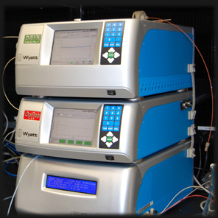SEC-MALLS
Size Exclusion Chromatography - Multi-Angle Laser Light Scattering
When light passes through a medium such as a solvent, even a transparent one, interaction with the molecules leads to scattering off the axis of the light beam. This may be observed by a sensitive detector and its intensity measured at different angles to the beam. If a solute of different refractive index is present this will lead to an excess scattering dependent on the concentration of solute but also on its molar mass and for large particles, on the scattering angle. In a suitably calibrated system this may be used to determine the molar mass of the solute. The angular dependence for large particles (>200 kDa) may be used to estimate size (i.e. radius of gyration). Our system has been upgraded with a QELS (dynamic light scattering) detector which allows direct determination of hydrodynamic radius down to about 2 nm for suitable samples. The system is mainly used for protein analysis but is equally capable of dealing with carbohydrates and synthetic polymers given suitable
columns and solvent systems (check with TF staff).
Because accurate concentration determination is vital for estimation of molar masses, the system also includes a refractive index detector - proteins have a very consistent concentration dependent effect on refractive index of solutions. Harnessing these two instruments to a chromatography system allows buffer before and after eluted peaks to be used as a very accurate reference baseline, avoiding the elaborate buffer matching required for accurate work on batch samples.
Applications
Some applications:
- Solution molecular mass determination. Calibration of elution times against molar mass on size exclusion columns uses well behaved globular soluble proteins. Unfortunately many sample proteins are not well behaved e.g. they may stick to the column and elute later than expected leading to erroneously low estimates of molar mass. The light scattering system will provide accurate estimates of molar mass for homogeneous samples and will indicate where peaks are composed of mixtures either of different oligomers (mass varies across peak) or conformers (peak shape indicates multiple species but mass is the same). The software provides estimates of polydispersity.
- Size determination. For larger proteins (>200 kDa) and some other macromolecules the amount of scattered light varies with angle of detection in a way that depends on the size (strictly radius of gyration) of the molecule. If the molar mass is also determined then inferences can be drawn about the shape of the molecule - globular or rod shaped etc.
Facilities
Wyatt Dawn HELEOS-II 18-angle light scattering detector and Wyatt Optilab rEX refractive index monitor linked to a Shimadzu HPLC system comprising LC-20AD pump, SIL-20A Autosampler and SPD20A UV/Vis detector
Accessories
Users are encouraged to employ their own size exclusion columns subject to consultation with Technology Facility staff - you know what has been down your own columns and how they perform with your samples. Four TF columns are available:
| Superdex 200 HR10/30 column | Protein MW | 10 to 600 kDa |
| Superdex 75 HR10/30 column | Protein MW | 1 to 70 kDa |
| Superose 6 HR10/30 column | Protein MW | 30 kDa to 2 MDa |
| Superdex peptide HR10/30 column | Protein MW | 100 to 5000 Da |
A batch mode microcell cuvette is available. Use of the system in batch mode avoids the dilution effects attendant on size exclusion chromatography but requires very careful attention to buffer matching for accurate results. The system does not have a fraction collector but eluted peaks may be collected manually if necessary
Samples & buffers
The autosampler system is arranged to use 100 µL injections from 120 µL sample volume though smaller volumes are possible. Small proteins (< 10 kDa) give low light scattering signals and may need a high concentration. Sample concentrations of 2.5 to 3 mg/mL will usually give good results both for MW determination and
QELS (hydrodynamic radius) analysis but lower concentrations (1 mg/mL) are usable for MW measurement. Although the detectors are capable of dealing with quite large particles, the column should not be used as a filter - precipitates and insoluble material must be removed by centrifugation or prefiltration.
Users should provide their own buffers unless arranged previously with Technology Facility staff. Buffers must be made from AR grade or better reagents in high quality (Elga, Millipore or HPLC grade) water and filtered through 0.22 µm filters. Small particles in the eluent or shed from the column will cause high backgrounds in the light scattering signal thus degrading the data. It is advisable to match the buffer in the samples with the running buffer - this will minimise the artefact peak in the refractive index signal seen at the column bed volume.
You will also require filtered water and 20% ethanol for equilibration of the column - most columns are stored in 20% aqueous ethanol. The system includes an on-line degasser so prior degassing is not essential. The system is compatible with most buffer systems but please consult Technology Facility staff if you wish to use low pH high salt buffers over extended periods (contact with stainless steel parts).
When arranging time on the system please remember to allow for column equilibration and cleaning steps - often conveniently done overnight.
Links


